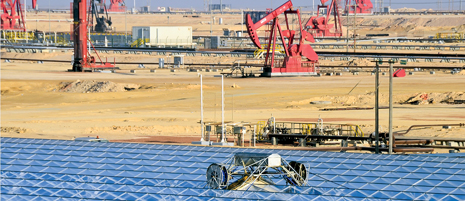Innovative thinkers
GlassPoint: Harnessing the power of the sun
|
Whether you produce shale gas in the U.S., oil sands in Canada or coalbed methane in China, one key consideration is constantly on an operator’s mind: cost. Personnel costs, transportation costs, equipment costs. They all play a part in determining a project’s economic viability, especially where power costs are concerned.
Considering the amount of money companies spend each year on power to fuel production operations, the team at GlassPoint, a manufacturer of solar steam generators for EOR applications, set out to reduce power costs in the field. After taking some time to understand the market, GlassPoint was ready to design a product that would replace natural gas-burning steam generators with solar-powered units. When comparing gas-fired steam generators to his firm’s solar-powered system, GlassPoint CTO Pete von Behrens said the difference in operator cost comes from opting out of a 30-year natural gas bill, which is bound to fluctuate, in favor of an upfront investment in the system, and relatively minimal maintenance. In Oman, where wind and dust can be detrimental to oilfield operations, the system employs a proprietary Enclosed Trough glasshouse to protect thousands of aluminum mirrors that focus sunlight on water-filled boiler tubes to generate steam. The most notable form of maintenance that the system requires is automated washing of the glasshouse roof, which can be carried out within 24 hr, sans personnel or downtime. The key to turning a profit in the global oil and gas market, especially in challenging plays, is often the ability to utilize available resources to their fullest potential. In the U.S., for example, natural gas has become a standard, relatively cheap feedstock for the growing LNG and other processing industries. However, in the Middle East, home to GlassPoint’s pilot solar EOR project, gas resources are more limited, and rising costs have made gas less attractive as an industrial fuel source. In Oman, where GlassPoint and Petroleum Development Oman (PDO) are running an EOR project at Amal West field, historically-low natural gas prices are set to double to $3/MMBtu by 2015, with additional increases later. This hike, in a region where fuel prices have been comparatively low, means that the use of solar-power steam generation frees up natural gas resources for use elsewhere, said von Behrens. As Middle Eastern countries, including Oman, look to diversify their economies, which are often dominated by oil production, the ability of companies like PDO to redirect natural gas represents a major benefit. Although GlassPoint delivers energy at less than $5/MMBtu, which is competitive with natural gas, the company is set apart from traditional systems by the fact that the gas saved can then be exported as LNG or otherwise reallocated for private sector use. In competitive systems, solar-powered steam generation can climb as high as $18/MMBtu. But, GlassPoint’s enclosed trough successfully protects against wind damage, often the most critical factor in solar generation, and maximizes one of Oman’s other plentiful natural resources: sunlight. Outside of the Middle East, California, with its Low Carbon Fuel Standard, is another location where solar-powered steam generation could be economical. As the availability of different feedstocks, including natural gas, changes in coming years, operators would be wise to consider the use of solar technology earlier in the design process, said von Berhrens. Aiming for a closer integration between oilfield service facilities and solar-powered technology means companies might be able to ease the transition into EOR activity, possibly reducing or avoiding downtime. Like costs, the ability to employ solar power generation should always be in the back of an operator’s mind. |
- Applying ultra-deep LWD resistivity technology successfully in a SAGD operation (May 2019)
- Adoption of wireless intelligent completions advances (May 2019)
- Majors double down as takeaway crunch eases (April 2019)
- What’s new in well logging and formation evaluation (April 2019)
- Qualification of a 20,000-psi subsea BOP: A collaborative approach (February 2019)
- ConocoPhillips’ Greg Leveille sees rapid trajectory of technical advancement continuing (February 2019)



